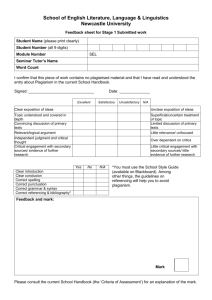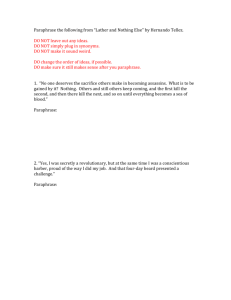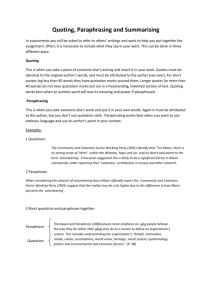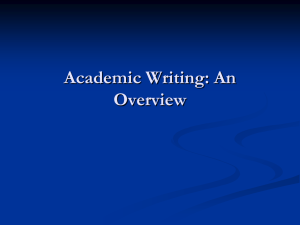REFERENCING & PARAPHRASING
advertisement
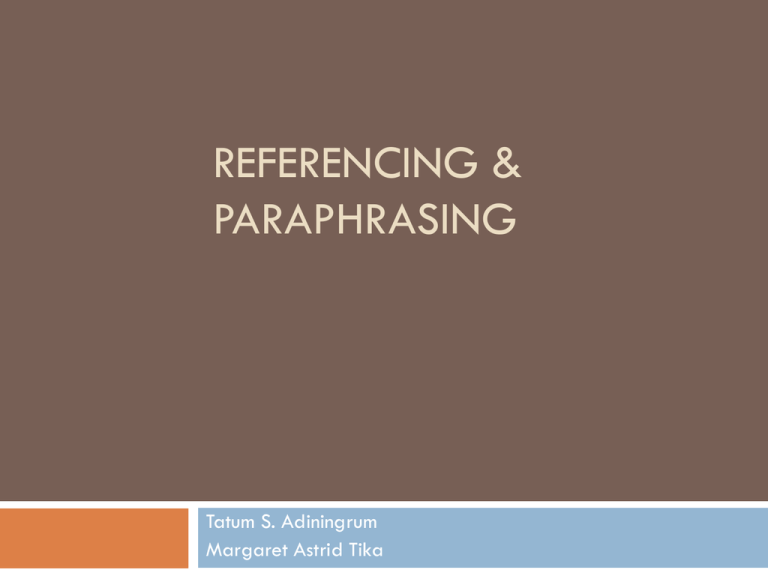
REFERENCING & PARAPHRASING Tatum S. Adiningrum Margaret Astrid Tika Workshop Aims To introduce referencing style used at Binus International To introduce summarising, quoting and paraphrasing skills To introduce reference list Referencing What is referencing Referencing is a system used in the academic community to indicate where ideas, theories, quotes, facts and any other evidence and information used to support your assignments, can be found. (Staffordshire University, 2008) Referencing method: American Psychologi Association (APA) – used at BI Harvard style Note System etc Why do you need to reference? To show that you appreciate other people’s ideas To show that you have done your assignment, not only the paper result, but the research that goes with it To give direction to other people who might need to trace your source. To avoid plagiarism accusation What do you need to reference Anything that is not your own idea. In Academic Writing, this often includes, but is not limited to: Books and E-books Journal articles, both paper and electronic; Internet sources; Articles from magazines and newspaper; Lectures and seminars; Interviews; E-mail communication; Telephone conversation; Thesis/Dissertation Your own past assignment. Basically, everything that you use to build your argument and does not come from your own thinking. However, common knowledge does not need to be cited. QUOTING, SUMMARISING & PARAPHRASING How to blend yours and theirs 1. Quoting Direct quote: copying a source word-by-word, without alteration. Short quote: As plagiarism is often seen as an academic offence, the treatment of plagiarisers is mostly through “catch and punish” (Devlin, 2006, p. 46), thus the focus is how to deal with students when caught. According to Diamond (1998), “Because technology begets more technology, the importance of an invention’s diffusion potentially exceeds the importance of the original invention” (p. 301). 1. Quoting Long quote: In relation to students from non-English speaking backgrounds, Scollon (1995, p.6) argues: The apparent difficulty that at least some non-native writers of English have incorrectly using reference, quotation, and paraphrase, and in avoiding plagiarism, might be better construed as reflecting a different ideological base. That is, some of this difficulty should be understood not as an inability to learn something simple, but rather as unconscious resistance to an implicit ideology… Examples taken from Adiningrum (2008). 1. Quoting You use quotes: - When you feel that the author’s words are very powerful and that you cannot paraphrase them without changing their meaning or impact to the readers. Do not overuse quotations, treat them like a precious jewel! 2. Paraphrasing (Indirect quoting) In simple words: to write other people’s ideas in your own words. Process: Reading the material - complete understanding of the ideas – rewrite in your own words, in your own style It is a skill, thus it will get better with practice. It is not, however, substituting words with their synonyms! Paraphrase a sentence when you want the readers to understand all of its points. Example: Original: Students frequently overuse direct quotation in taking notes, and as a result they overuse quotation in the final research paper. Probably only about 10% of your final manuscript should appear as directly quoted matter. Therefore, you should strive to limit the amount of exact transcribing of source materials while taking notes. Lester, J. D.Writing Research Papers. 2nd ed. (1976) 46-47 A. Acceptable paraphrase: In research papers, students often quote excessively, failing to keep quoted material down to a desirable level. Since the problem usually originates during note taking, it is essential to minimize the material recorded verbatim (Lester, 1976). Taken from Adiningrum, 2008. B. A plagiarized version: Students often use too many direct quotations when they take notes, resulting in too many of them in the final research paper. In fact, probably only about 10% of the final copy should consist of directly quoted material. So it is important to limit the amount of source material copied while taking notes (Lester, 1976). 3. Summarizing A summary presents only the most important ideas of a passage, leaving out specific details. Summarize a passage when you want to give a brief overview of a text. Remember! Summarized texts must be cited too. How to make a good summary 1. Read carefully, and find the main points of the paragraph. 2. The points presented should follow chronological order 3. Leave out the flowery details, stick to the important main points! 4. Reference List You need to give a comprehensive reference list at the end of your essay. It contains of all sources you have written in your essay. APA Sample Reference List Reference Adiningrum, T.S. (2008). Plagiarize Like an Expert, a handbook for Indonesian students at Flinders University. Unpublished assignment. (Unpublished material) Department of Educational and Training (2005). Professional Learning in Effective Schools: The Seven Principles of Highly Effective Professional Learning. Melbourne: Leadership and Teacher Development Branch, Office of Education. (BOOK) Salmi, J. (2009). The Challenge of Establishing World-Class University. Washington DC: The World Bank. (BOOK) Simons, P. & Ruijters M.N.C (2004). Learning Professionals: Towards an Integrated Models. In Boshuizen H., Bromme, R. & Grubber, H. (eds), Gaps & Transitions on the Way from Novice to Expert. New York: Kluwer Academic Publishers. (CHAPTER ON A BOOK) Staffordshire University, (2008). Referencing Terminology & Abbreviations. (downloaded 10 August 2010 from http://www.staffs.ac.uk/uniservices/infoservices/library/find/referen ces/jargon/index.php (Webpage) Webster-Wright, A. (2009). Reframing Professional Development Through Understanding Authentic Professional Learning. Review of Educational Research 79 (2), pp. 702-739. (JOURNAL) Where can you find the reference information needed in a book? Publisher Edition Authors Location Year of publication Do I have to cite everything? No! You do not need to document: Widely known facts, or Information or judgment considered “common knowledge”. Consider the followings Which information is common knowledge? a. Barack Obama is the 44th and current President of the United States. b. Obama’s policy highlights the importance of international cooperation. So what do we do with the other information? We cite it! Broad and Chang (2010) pointed out that Obama’s policy highlights the importance of international cooperation. Note: the above is a paraphrase. Do not panic... You will be introduced further to the skills of using summary, paraphrase and quotes in the Academic English class. You can find guides to APA referencing used at BI in our website: http://www.binus.ac.id/els/ , or http://www.waikato.ac.nz/__data/assets/pdf_file/00 17/51632/APA_Referencing_6th_ed.pdf (quick guide) Useful Glossary Academic Integrity all work which is presented is produced by the student alone, with all sources and collaboration fully acknowledged Cheating gaining unfair advantage from other students intentionally Collusion submitting work as if it had been done individually when it has been done jointly with one or more other person unless the topic coordinator has indicated that this is acceptable for the specific work in question Useful Glossary Collaboration working together with other students as directed by your lecturer/tutor, in which each student contributes equally to the end results Hidden memory presenting what is thought as an original idea while it is actually a result of forgotten past reading Paraphrase reproduction of other people’s ideas in your writing using your own words Useful Glossary Patchwriting artificial make-over of other people’s sentences in your writing, might be a form of a bad paraphrase. Plagiarism the use of another person’s words or ideas as if they were one’s own Reference every source that you use to produce your writing; to provide acknowledgment within and at the end of your piece of writing Quote reproduction of other people’s words in your writing without alteration. Reference List Adiningrum, T.S. (2008). Plagiarize Like an Expert, a handbook for Indonesian students at Flinders University. Unpublished assignment. Staffordshire University, (2008). Referencing Terminology & Abbreviations. (downloaded August 2010 from http://www.staffs.ac.uk/uniservices/infoservices/library/find/references/jar gon/index.php) University of Houston; Academic Center. (2003). Learn to summarize. Retrieved from http://www.uhv.edu/ac/research/write/pdf/paraphrase.pdf


